September 11, 2023
10 Things I’m Looking Forward to in September

- Getting back to blogging, both writing and reading!
- Not having a rash (maybe?)
- Cool nights
- Weekends in the city
- Turning the oven on
- Promoting my book. (Did I mention I have a new book out?)
- Squash season!
- the Victoria College Book Sale
- working on my WIP
- Autumn leaves…
June 23, 2022
A June like all the other Junes
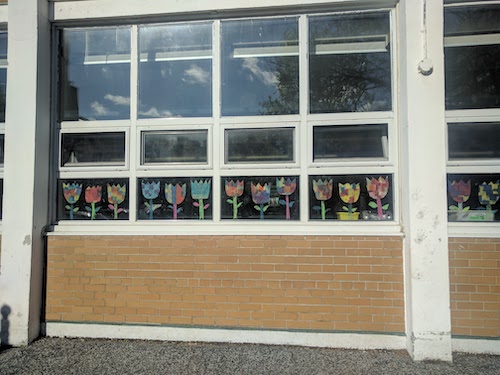
It’s been three years since we’ve had a June like this June, a June like all the other Junes before it. My kids walking to school in shorts and sandals, spring light shining through lush green trees into their classroom windows, and the calendar packed with dates for the school picnic, school dances, graduation, and end-of-the-year trips. If my email inbox is any indication—packed with calls for bake sale contributions, teacher gift collections, volunteers and chaperones—nature, as they say, is healing.
If all goes according to plan in the next week, the 2021-22 school will turn out to have been something close to normal, two weeks of virtual learning aside, albeit with two-thirds of it spent in cohorts, high schoolers in those ungainly “quadmesters,” the experiment that has been hybrid learning, and mask requirements. Some of these strategies for reducing infection have been more effective (and less disruptive) than others, but I’m grateful for those that worked, for the gift of vaccines, and for the incredible dedication of teachers and school staff which has meant our kids get to go to school every day, see their friends, learn in person, play at recess, and all the other normal things that all kids should get to do.
As a parent in Ontario, a province whose children have spent more time out of the classroom since March 2020 than anywhere else across the country, something close to a normal school year is a gift I will never take for granted.
But I also remain frustrated that too many voices—some of them prominent, loud, and speaking with real authority—have spent the last two years and more insisting that such success was unachievable. These failures of imagination have had real consequences for children and families across the province, and served to undermine progressive values, faith in public health, and the possibilities of our collective efforts.
In 2020, however, some of this seemed understandable. So much was still unknown about Covid-19, with limited medical treatments available, and vaccines far off on the horizon. And so, even as students across Europe began returning to school in the spring of 2020, students in many Canadian jurisdictions would finish up their school year online, in Ontario this setting a most unfortunate precedent.
It didn’t help that bad-faith actors came to hijack the conversation so that questioning restrictions like school closures started to seem like possible shorthand for not taking the Pandemic seriously. Or that our media was so US-centric that it was hard to see examples of Covid being managed any way but terribly. It didn’t help either that, in Ontario, the government was slow-moving on measures to improve school safety, and then rolled out a program for virtual learning that made parents feel like they were being forced to pick between two not-great choices. To complicate matters further, by September 2020, Ontario was coming out of a year of labour disruptions by teachers and school staff, which meant tensions were high and political rifts deeper than ever. In particular, I recall a tweet from exclusive private high school St. Michael’s College School, of which Ontario Education Minister Stephen Lecce was an alumnus, spotlighting gleaming new handwashing stations and plexiglass room dividers. Meanwhile public school students were being promised six feet of distance between desks in classrooms where there was literally not enough space to accommodate such dimensions—the disconnect was pretty staggering.
Sending my children back to school September 2020 was a nerve-wracking endeavour, but it was a choice whose risks we felt comfortable taking since no one in our household had a health condition that made them vulnerable, my husband and I both working from home meant our chances of spreading the virus were low, and—I think, most essentially—because we were already well connected to our local public school whose staff we trusted absolutely to help keep our children safe.
But we were still nervous, and I soon realized that I would have to quit Twitter in order to have my kids attend school without my mental health being compromised, because all the voices on that platform—from doctors, and people who thought they were doctors because they followed doctors, and activists, and politicians, and pundits—were just too much for me to handle.
I also ended up leaving the several parental advocacy groups I’d followed in previous years to show my support for public education, mostly because they too were piling on the Twitter hyperbole and using every opportunity to get a shot at our ding-dong government. (The thing about ding dong governments is that you’re always going to get a shot, so you actually have to be discriminating at going about it or else it stops having meaning.)
The low point, for me, came when I sent a DM to a representative from one of these groups, which was then keeping tabs on daily case counts of Covid cases reported in Ontario schools. (A number that was, in retrospect, so low that it almost seems quaint now.) And I inquired to the representative as to whether they were perhaps stoking fear and anxiety in sharing these numbers outside of the context of what a small proportion of students these cases actually represented, and—even more important—that school spread really didn’t seem to be a factor.
“Let’s engage with reality, rather than just trying to push your narrative, because that undermines your credibility,” was basically what I was saying, but this person was uninterested in that. Responding that the numbers were likely undercounted anyway, and that I was being ableist and racist in denying the impact of Covid, since it disproportionately affects the most vulnerable in our communities.
The latter point most certainly the case, but doesn’t that just underline the importance of dealing in facts and not engaging in inflammatory rhetoric? Because the stakes really are that high.
You’d think people might have learned something from September 2020, when schools reopened and everyone lost their minds, but we didn’t. In Ontario, schools closed again after the Christmas holidays, students returning to their classrooms for about six weeks, and then schools closed a second time after delayed spring break. I recall commenting on Facebook that it might be nice if schools could just reopen for a few weeks in June for just a bit of closure, so we didn’t just keep adding to the trauma of everything having ended so abruptly two years in a row, and other people shouted my point down. It just wasn’t worth the risk. It wasn’t possible, they reported with a glib kind of nihilism. People who lived in Twitter far more than they actually went out into the world telling me how it was, because they’d seen it in their timelines.
Children returned to school again in September 2021 with a virulent new strain on the rise, and again in January 2022, and each time I couldn’t help but think how advocates and experts had squandered so much of their capital by making something massive out of the challenges of September 2020. So that by the time spring 2022 rolled around and everything was so much worse, nobody was listening to them anymore. At a moment when advocacy was necessary, most normal people, altogether pandemic-weary, had tuned it all out. Because of the Public Health Twitter star whose open letter in January 2022 predicted “sudden mass infection” and effects that would be “catastrophic.” The people who’d decided that medical experts advocating for schools to reopen were in kahoots with Doug Ford and developers to destroy the green belt. The hysterical Instagram power-points warning when children returned to school after March Break, “STUDENTS ARE GOING TO DIE. TEACHERS ARE GOING TO DIE.” Until the messaging was just as uninformed and divorced from reality as that of anti-vaxxers.
It’s not that people were wrong that bothers me. Surely all of us are glad that the most dire predictions regarding Covid-19 often did not come to be. I understand too that this has often transpired because of urgent messaging which led members of the public to change their behaviour, changing trajectories for the better. It’s how public health is supposed to work.
But I am bothered by the lack of reflection by people with prominent platforms. I am angry that a curious combination of cowardice, defeatism and self-righteousness led to children in our province being out of school for months during periods where we were free to eat and drink in bars and restaurants. I am angry that the same people were wrong again and again, and that all those same people are still furiously tapping away at their Twitter feeds, never once displaying an ounce of humility or contemplating the remotest possibility that not everything is going to end in disaster.
All this matters because we live in a moment of enormous challenge on a variety of fronts, and our society is certainly never going to be able to meet these if how we grappled with Covid in schools is the precedent. If our most prominent voices continue to be steeped in cynicism, egotism, more adept at criticism than anything constructive, more concerned with amplifying their own voices, messages, and political agendas than actually listening, and learning, and figuring out how together we can make things work.
Because we can make things work—the success of 2021/22 is a testament to that. And I don’t know if it would be so unwise, when the next big crisis rolls around, if we just let school teachers and staff be the ones to tell us all how to solve it, and everybody else can be quiet for once.
January 19, 2022
Voices
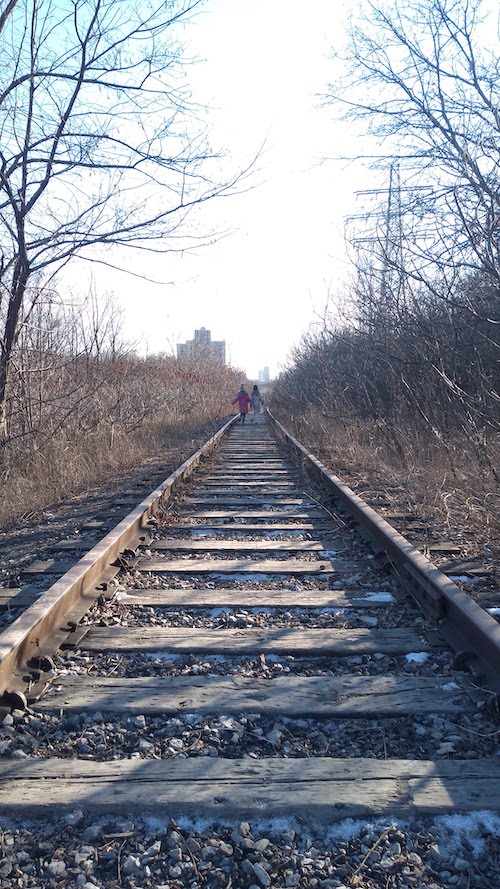
In Autumn 2020, I had to quit twitter because its chatter about school reopening and politicization of such things had made ordinary life impossible for me. Too many voices, too many egos, and the issue had become a power struggle instead of a project our communities had to partake in together. (Twitter also works to undermine public trust—in public health, in each other. And that’s bad news.)
And now, all these months later, I’m very glad I was able to get those voices out of my head, to keep things simple, to follow public health advice and send my children back to school today without the decision being an agonizing one, which has been the case for parents in so many other jurisdictions all along.
Every time our children have returned to school in Ontario, the rhetoric has been over the top, but never more than now. And is it now that such a reaction is finally justified? As ever, I don’t know. But also no one does. And if things are different this time, I can’t help but think of how much real currency was wasted by politicization, by advocates failing to be measured and careful in their responses to what was actually happening on the ground over the last two years.
Social media is brutal, friends. Last week several super smart people I know shared a post about an edited/out of context quote by CDC’s Dr Walensky regarding the deaths of people with comorbidities as “good news”. While people were advocating against ableism, they were also spreading misinformation and furthering right wing propaganda. It’s so easy to be played.
Unless you are actually a public health official, it really might be a good idea to unplug from all this and often. Talk to the actual people in your life—your family doctor, even. Beware of stats and clips devoid of their context. Be thoughtful about what you share online. Be curious. Ask questions. But also do your best to trust the people who know things when they give you answers.
I’m wishing good things for all of us in the weeks ahead, ESPECIALLY our kids.
September 4, 2020
Why I am Still Not Freaking Out About School
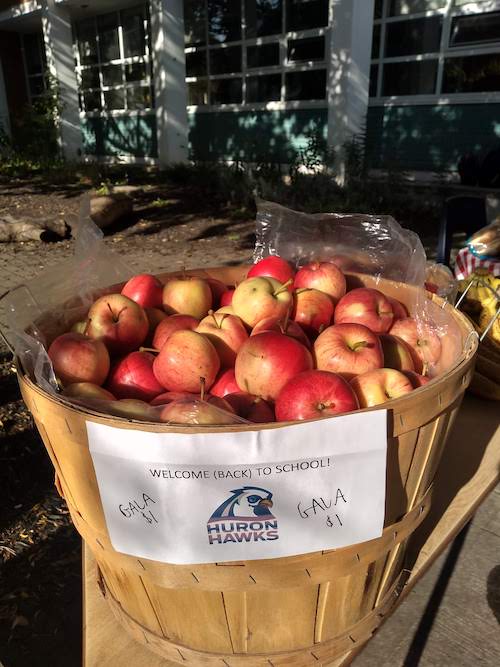
I am still not freaking out about school. There are a lot of reasons why not, and some of them include denial, but mostly it’s that me freaking out about school isn’t going to make anything better. It will be as futile as all-caps screaming at the Education Minister on Twitter, and I don’t do that anymore. (Most of the time.)
This is not to say that I have done nothing. (There is a wonderful plot of land in that space between “freaking out” and “doing nothing,” and I’ll meet you there.) A bunch of parents with smarts and agency put together an advocacy group calling on the government to put caps on class sizes, which would go far in actually applying the advice of medical experts that keeping groups small lowers risk of disease transmission.
I have sent the letter, I have encouraged other people to get involved. I have also emailed the Minister on my own behalf. I have thought about the importance of public education, for my own family, and also across the board. (Have you listened to Nice White Parents yet? It was fantastic and challenging in the very best way. I learned so much in ways I wasn’t expecting…)
I have also not really engaged with other parents about their own thoughts on sending their kids back to school, because in general, I just don’t care. Quite magnanimous of me, because usually I am judgey as all get-out, but the best thing about there being no perfect choice is that there is no terrible one either. Usually the idea of “choice” is totally sanctimonious (and I should know—I cloth diapered) and kind of gross, not remotely as neutral as it would like to be (don’t get me started on “school choice”) but this is a different kind of situation, or maybe I’ve just evolved since the spring (I doubt it).
You will make your choice based on your own childcare needs, and your own child’s social needs, and the health of the people who live in your home, and the size of your school, and your comfort with school and teachers in general based on previous experiences, and your child’s personality, and how well virtual schooling went in the spring, and your own level of anxiety, and infection rates in your area, and whether it’s really worth it to have the people in your family start wearing pants again.
I am sending my kids to school because local infection rates are really low; because I want to demonstrate my trust and support in the public school system which I fervently believe in as much as I believe in any system, because the government is telling us that it’s safe to do so and I also believe in trusting the government (because the government is more than just the ding dongs and because not trusting the government can turn a person into a lunatic); because public schools are the only choice that is financially possible for me; because my kids are old enough that I trust them to follow processes and direction, and be smart; because when I think about sending millions of kids into schools my head explodes BUT when I think about the fact that my children will be under the supervision of two specific teachers (I don’t know who they are, but it’s always easier to break a thing down into parts) I feel better because I know how seriously teachers take their responsibilities; because the risk of serious harm to ourselves or others is statistically lower than in many activities we partake in regularly; and because if things go wrong and we’re not comfortable/it’s not working, I can take them out of school again, as we’re flexible enough with two parents working from home that this is not a big deal—and the last six months has taught me that missing school does not mean missing education. Even if they miss that remote learning transfer window, or whatever, it will be fine. Kids are resilient. I think we parents should strive to be more so.
By which I mean we should not be freaking out, I mean. Whether you are sending your children to school or not. We all have our reasons. And other people’s reasons really shouldn’t even apply to you
There is also a plot of land I’d like to meet you in between the space where you might shrug off the pandemic as a hoax and regard mandated mask wearing as a government conspiracy and where you constantly share articles from CNN about outbreaks at Georgia high schools and wake up with night terrors at the premise of a second wave (which in news headlines always gets calls a “DREADED second wave). Another plot of land between the pandemic being a hoax AND an awareness of the fact that news outlets want you clicking on their stories all the time and keeping you anxious works to their benefit. Stories about Georgia are not necessary applicable to my situation.
In March and April, children hung rainbows in their windows with signs that said “Everything is going to be okay.” In March, for a week or so, I was convinced that we were all going to die in the coming days, and it turns out the children were more correct than I was. I have been working hard to channel their optimism ever since, and in many ways, it’s been the right path. And no, “everything” is not going to be okay, but when was it ever? In general, we have been and we will continue to find a way for ourselves through all this, and working hard to keep our responses calm and measured goes a really long way.
April 10, 2019
I didn’t rally on Queen’s Park in 1997
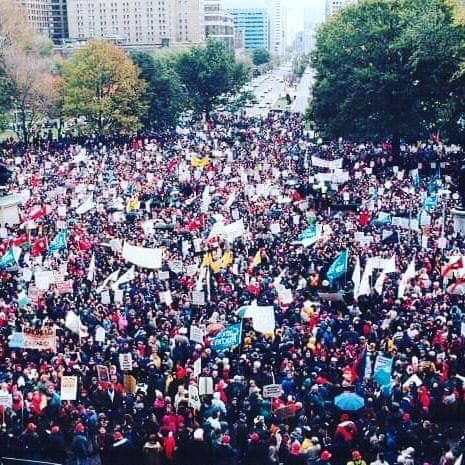
I didn’t rally on Queen’s Park in 1997, the last time an austerity government set its sights upon Ontario’s schools and teachers fought back. In my defence, I was a student in my final year of high school. And if walkouts were being organized, I didn’t notice. I recall thinking that politics shouldn’t concern me; surely the adults could work it out? I didn’t understand that teachers were standing up against policies whose destructive effects would be felt for generations.
And this is not hyperbole. When my child began kindergarten in 2013, elementary schools were very different from what I remembered. Apart from the implementation of full-day kindergarten, it has been decades since major investments were made in Ontario’s education system, a system whose underfunding was signed into law in 1997 when Mike Harris’s government changed the funding formula, the policy my teachers were rallying against.
Which is why these days, teacher-librarians work half-time, if at all. At my kids’ wonderful school, we don’t have a vice-principal, or a music teacher. Parents volunteer in the office to help our lone administrator keep up with her tasks, and they also tutor students in literacy programs. Parent fundraising replaces decades-old gym mats, replenishes classroom libraries, and leads initiatives to redevelop school playgrounds. Education Assistants and other support staff are rare in classrooms, while teachers—carrying on heroically—face growing numbers of students with special needs.
Meanwhile, Ontario schools—literally—are falling apart, facing a growing $15.9 repair backlog. In 2016, thanks to advocacy from grassroots organization Fix Our Schools, the Liberal government committed to $1.1 billion for school repairs, which was a start, but not enough. And then weeks after their election in June 2018, Doug Ford’s Progressive Conservatives eliminated the Cap-and Trade program—“Promises made, promises kept,” Ford and his ministers crowed—the school repair fund disappearing with it.
So this is the system the government is looking to cut from to pay for overpromised tax breaks. When high school students walked out of classrooms on April 4, they were standing against pedagogically unsound ideas including increased class sizes, mandatory e-learning, the elimination of thousands of teachers, and specialized programs and classes. At the elementary level, junior class sizes are rising, teaching staff are being laid off, special grants and programs are eliminated, along with plans to implement Calls to Action from the Truth and Reconciliation Commission into the curriculum, and there has been no additional funding for students who’ve lost support through the province’s autism program.
The students who walked out—the Premier dismissed their organizing as coming “strictly from the union thugs”—are so much more aware of their world than I was at their age.
“I heard about the cuts and I was just kind of mulling it over for the weekend,” said Natalie Moore, 18, who organized the walk-out. “I kind of realized that students, especially as leaders, need to step forward and take it into our own hands.”
And on April 6, two days later, thousands of teachers, parents, children and allies—galvanized by students’ actions days before—would do the same, gathering at Queen’s Park to stand against cuts to schools and this government’s unwillingness to invest in public education.
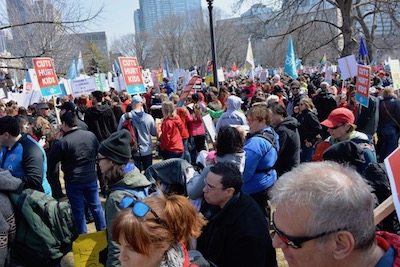
It was another demonstration that Ford and Thompson would write off as a union stunt, but I was there, and I’m not in a union. Neither are my neighbours, my children, their classmates, and parents and grandparents who gathered in a downtown playground on Saturday morning so we could walk to the rally together. We were there to stand with our teachers—our partners in our children’s education—and because we believe in a well-funded education system where every child has a chance to succeed.
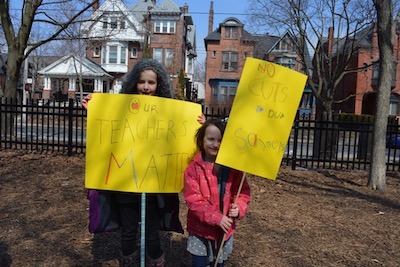
For me there was another reason to rally at Queen’s Park, and it’s to make up for my failure to do so two decades ago. I see a direct line between my inaction then and the ways my children are being let down today. They deserve an education as excellent as the one that I received in Ontario schools, as do all those students who walked out of class last Thursday, those with the courage and conviction to use their voices and stand up for schools, and not simply wait for the adults to work it out.
And we are the adults now. So let’s fight back, and finally be the kind of people that Natalie Moore and all our children can be proud of. They’ve set the most incredible example for us to follow—and we’re proud of them already.

Next steps: Ontario parents with school-age children: the group West End Parents For Public Education Toronto has created an incredible tool kit that we are using at our school to rally together and fight back against the government’s attack on public education. Please take a look at it!
- If you’re on the council at your child’s school, there is lots of practical advice and things to do—and if your council is not political, let me tell you that ours wasn’t either but I’ve found lots of support from my colleagues on council as we take action for our kids.
- If you’re not on council, you can still organize (and possibly the people on your school’s council will be happy someone else is doing it!).
- And if you do not have the time, please reach out to your school’s council and let them know that these issues are important to you and make sure they know about the WEPPE tool kit.
- To those of you whose children go to private schools, I hope your communities will also think of ways to be allies for public schools and support this cause.
An important thing I’ve learned in the last year is that you don’t need to wait for permission to start acting on the issues that are important to you. Please reach out if you have any questions or would like to work together.
September 26, 2018
Spending a Morning at School
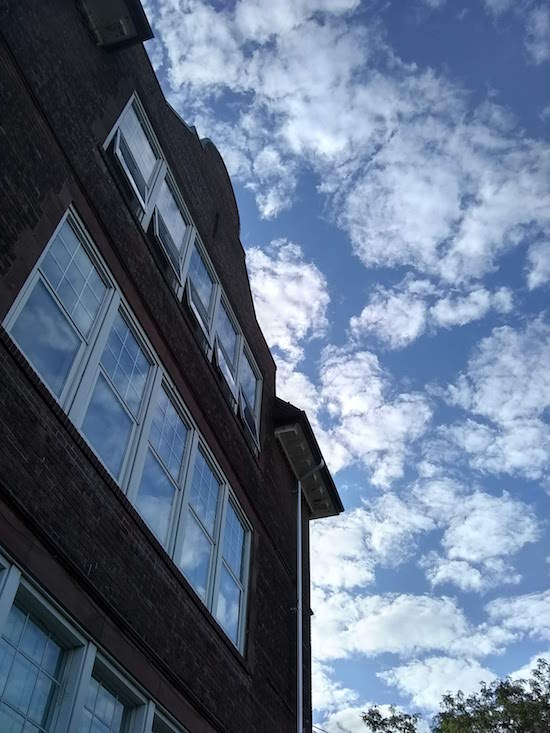
“All those beautiful back to school pics are a reminder (to me, anyway) of how deeply vested so many people are in the education system & that it can be political dynamite to mess with it recklessly.” —Shawn Micallef
One reason I like volunteering at my children’s school is because I’m nosy. And when a nosy person commits to spending a few hours administrating a fundraiser from the office—sorting order forms by classes with letters to parents—that person is not simply organizing papers. She is paying attention. And she is welcome to be there paying attention as she shuffles papers, because she’s going to be bringing in a few hundred extra dollars to the school coffers, which are chronically underfunded. Every little bit helps, and teachers and school administrators are expert at stretching those dollars at far as possible, finding value, and making them count. So I’m happy to help, and besides, there are plenty of places for me to work—the Vice Principal’s office? The nurse’s room? Because, of course, there is no money either for Vice Principals and Nurses anymore, and the Secretary relies on volunteer support. Speaking of stretched, and I’ve not even got to Education Assistants (gone the way of the Vice Principal…) or caretaking staff (of which there are a few, but as few as possible due to budget constraints). This is not austerity, but also I can’t remember the last time our provincial government made a major investment in public education. And yet there is something miraculous about the way it all functions anyway, credit for all of which is due to the amazingness of people.
Part of the reason it works is because we expect it to—every morning we drop off our children, those extensions of our hearts, and then we go out into the world to do the things we do, and we take it for granted that our children are safe and cared for, that they’re learning, that they’re even happy. And for many of our children, this is mostly true, at least on the good days. And when all our children went back to school in September I was struck by the reality that plenty of parents who were taking our schools for granted as much as I did had voted to elect a provincial government in June with no respect for teachers and a disdain for public education in general. (Our new Minister of Education’s background is managing a goat cooperative, and she has still given no media interviews about her portfolio which has been controversial since her government elected to dismiss an updated sex-ed curriculum [against the advice of experts] and cancel a curriculum rewrite that would have boosted Indigenous content. Her deputy is a twenty-one-year-old who was homeschooled and whose limited worldview is informed by his extreme religious views)
And how could they do that, I wondered. How could they send their children into the care of people whose profession their electoral votes had so undermined?
“Because they know teachers will still do the best possible job with their children,” answered my friend Dorothy Palmer when I posed that question on Facebook a few weeks ago, and Dorothy, a retired teacher would know. But I know too, or at least I’m reminded after the time I spent this week sorting papers in the office, paying attention. To the tiny people from kindergarten who had the huge responsibility of bringing the attendance down to the office this morning, in pairs of course. To the older girl who’d hurt her knee in gym and came to get ice, and also all the other people who came to get ice—after falling on the playground, getting hit by a soccer ball, going too wild on the monkey bars. Ice is the most tremendous tool, and it makes so many things okay again. Which the teachers know, the teachers who come into the office to check their mailboxes, who greet their colleagues jovially and say hi to students they haven’t seen since last year and remark on who has grown tall over the summer.
There was a little boy in the office this morning and it was his first day of school ever, and he was terrified, unhappy to be there. His dad was in the office filling out paperwork, but could hear his son crying down the hall where the boy was being comforted by an ECE. Over the course of my time in the office this morning, this small boy and his father were greeted by teachers, and welcomed to the school, and the kindergarten teacher came to ask if he wanted to come along to gym. When I finally left awhile later, the boy had joined his new class, no one was crying, and the relief on his father’s face in the hall reminded me of how good I felt when my eldest daughter finally stopped crying every morning for the first month of Junior Kindergarten, that maybe we could find a place here.
At our school, the Principal knows everybody’s name, and when it’s your birthday they put your name on the announcements and you get to come down to the office and receive a brand new pencil. The school Secretary is mostly magical and plays her guitar for the kindergarten classes. At our school, psychologists and speech therapists and other specialists visit to give support to kids who need it. My daughter has had occupational therapy help with handwriting, and speech therapy. When her Grade 3 teacher had concerns about her speech, she went back and talked to her teachers from the year before. At our school, our amazing music teacher retired after 28 years of teaching there, and (without her knowing) every single child at school, hundreds of them, had been taught a song just for her, and on her final day of school last year they sang to her, and a lot of people cried. (Our music teacher has not been replaced. What kind of school has music teachers anymore?)
I think sometimes people underestimate how good teachers are at doing their jobs, what experts they are in their professions. I absolutely know that the role of teachers in our society is shockingly undervalued, the incredible role these people play in our families’ day-to-day lives. A good teacher can change a life, and imagine what happens to a life when a kid has one good teacher after another. I sat in the office this morning, and said hello to a number of these teachers, and thought about what we’re trusting them with, up there with heart surgeons and bridge builders. Is there anyone more important?
Sit in a school office for a morning, and you get a glimpse into your community. Harried parents straggling in late, kids with disruptive behaviour, students living with their mothers in shelters because they’re fleeing family violence and the special needs that come with that. Our school specifies 10% of all money raised throughout the year go into a fund for students who are most in need, and this money has paid for eye glasses, winter clothing, gift cards at the holidays for families who wouldn’t otherwise be able to afford things. If a child shows up at school without a lunch for reasons other than a forgetful dad or mom, they will be quietly accommodated. Parents turn up with hugely pressing concerns which they seem blasé about, and others hysterical about incidental problems, and all of them are treated with care and consideration, and some other kid will arrive because he has a stomach ache and somebody will call his mom, and the day will continue, even after all my papers are filed. There is no such thing as extraordinary there, because everything is extraordinary all the time, and it works, because the people do, in spite of everything. I can’t imagine who’d we be without them.





